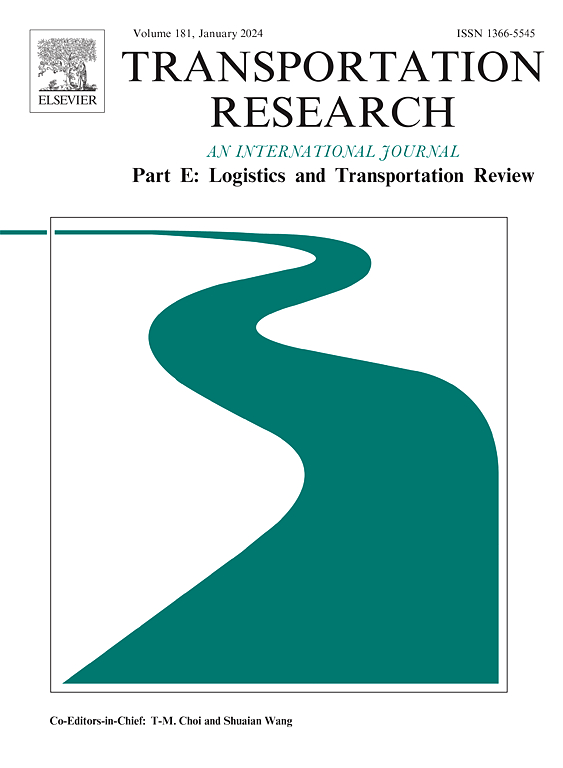利用数据驱动的方法来解决乘客到列车的分配问题
IF 8.3
1区 工程技术
Q1 ECONOMICS
Transportation Research Part E-Logistics and Transportation Review
Pub Date : 2025-03-03
DOI:10.1016/j.tre.2025.104037
引用次数: 0
摘要
了解地铁系统的客流分布是地铁网络规划和运营的前提。然而,由于自动检票(AFC)数据仅记录进出站信息,因此通过AFC数据和已建立的时刻表直接获取乘客分布仍然具有挑战性。尽管许多研究基于准确的时刻表输入探索了地铁系统的乘客分布,但由于乘客需求和车头时距的时空动态,参数收集和校准具有挑战性。本研究提出一种数据驱动的乘客-列车分配模型(PTAM)。利用两阶段高斯混合模型(GMM)计算了乘客上车的后验概率。该方法不需要精确的时间表输入,并且初始参数收集和最终估计过程都是自动化的,消除了手动校准的需要。以南京地铁为例,验证了该方法的有效性。此外,本研究使用PTAM计算车内乘客、留守乘客和乘客支付意愿(WTP)。结果表明,同一线路上不同站点的拥挤程度和留守程度存在显著差异。在晚高峰期间,乘客承担约50%的福利费用。研究结果可为管理者组织客流提供依据,为旅客出行决策提供指导。本文章由计算机程序翻译,如有差异,请以英文原文为准。
Utilizing a data-driven methodology to resolve the passenger-to-train assignment problem
Understanding the passenger distribution within the metro system is a prerequisite for metro network planning and operation. However, as automatic fare collection (AFC) data records only entry and exit information, directly obtaining passenger distribution through AFC data and established timetables remains challenging. Although many studies have explored passenger distribution in metro systems based on accurate timetable inputs, parameter collection and calibration are challenging due to the spatiotemporal dynamics of both passenger demand and headway. This study proposes a data-driven passenger-to-train assignment model (PTAM). The posterior probability of passengers boarding the train is computed using a two-stage Gaussian mixture model (GMM). This method does not require precise timetable inputs, and both the initial parameter collection and final estimation processes are automated, eliminating the need for manual calibration. Using the Nanjing metro as a case study, the effectiveness of the PTAM is demonstrated. Additionally, the study computes in-vehicle passengers, left-behind passengers, and passengers’ willingness to pay (WTP) using PTAM. The results demonstrate significant differences in crowding level and left-behind at different stations on the same line. During the evening peak, passengers bear about 50% of welfare costs. The findings can provide managers with a basis for passenger flow organization and guidance for passenger’s travel decision.
求助全文
通过发布文献求助,成功后即可免费获取论文全文。
去求助
来源期刊
CiteScore
16.20
自引率
16.00%
发文量
285
审稿时长
62 days
期刊介绍:
Transportation Research Part E: Logistics and Transportation Review is a reputable journal that publishes high-quality articles covering a wide range of topics in the field of logistics and transportation research. The journal welcomes submissions on various subjects, including transport economics, transport infrastructure and investment appraisal, evaluation of public policies related to transportation, empirical and analytical studies of logistics management practices and performance, logistics and operations models, and logistics and supply chain management.
Part E aims to provide informative and well-researched articles that contribute to the understanding and advancement of the field. The content of the journal is complementary to other prestigious journals in transportation research, such as Transportation Research Part A: Policy and Practice, Part B: Methodological, Part C: Emerging Technologies, Part D: Transport and Environment, and Part F: Traffic Psychology and Behaviour. Together, these journals form a comprehensive and cohesive reference for current research in transportation science.

 求助内容:
求助内容: 应助结果提醒方式:
应助结果提醒方式:


